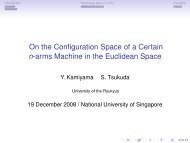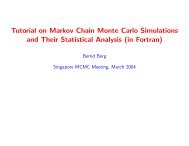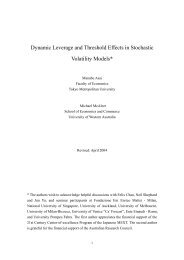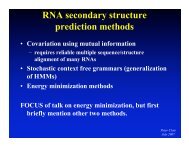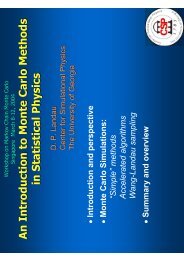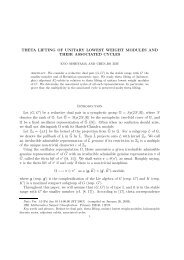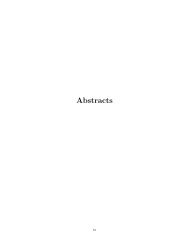Stein's method, Malliavin calculus and infinite-dimensional Gaussian
Stein's method, Malliavin calculus and infinite-dimensional Gaussian
Stein's method, Malliavin calculus and infinite-dimensional Gaussian
You also want an ePaper? Increase the reach of your titles
YUMPU automatically turns print PDFs into web optimized ePapers that Google loves.
D4 The application of the DDS Theorem <strong>and</strong> of the BDG inequality requires an explicit underlying<br />
(Brownian) martingale structure. Although it is always possible to represent a<br />
given <strong>Gaussian</strong> …eld in terms of a Brownian motion, this operation is often quite unnatural<br />
<strong>and</strong> can render the asymptotic analysis very hard. For instance, what happens if one<br />
considers quadratic functionals of a multiparameter <strong>Gaussian</strong> process, or of a <strong>Gaussian</strong><br />
process which is not a semimartingale (for instance, a fractional Brownian motion with<br />
Hurst parameter H 6= 1=2)? See [71] for some further applications of r<strong>and</strong>om time-changes<br />
in a general <strong>Gaussian</strong> setting.<br />
D5 It is not clear whether this approach can be used in order to deal with expressions of the<br />
type (2.15), when h is not Lipschitz (for instance, when h equals the indicator of a Borel<br />
set), so that it seems di¢ cult to use these techniques in order to assess other distances,<br />
like the total variation distance or the Kolmogorov distance.<br />
Starting from the next section, we will describe the main objects <strong>and</strong> tools of stochastic<br />
analysis that are involved in our techniques.<br />
3 <strong>Gaussian</strong> measures<br />
Let (Z; Z) be a Polish space, with Z the associated Borel -…eld, <strong>and</strong> let be a positive -…nite<br />
measure over (Z; Z) with no atoms (that is, (fzg) = 0, for every z 2 Z). We denote by Z the<br />
class of those A 2 Z such that (A) < 1. Note that, by -additivity, the -…eld generated by<br />
Z coincides with Z.<br />
De…nition 3.1 A <strong>Gaussian</strong> measure on (Z; Z) with control is a centered <strong>Gaussian</strong> family<br />
of the type<br />
G = fG (A) : A 2 Z g , (3.1)<br />
verifying the relation<br />
E [G (A) G (B)] = (A \ B) , 8A; B 2 Z . (3.2)<br />
The <strong>Gaussian</strong> measure G is also called a white noise based on .<br />
Remarks. (a) A <strong>Gaussian</strong> measure such as (3.1)–(3.2) always exists (just regard G as a<br />
centered <strong>Gaussian</strong> process indexed by Z , <strong>and</strong> then apply the usual Kolmogorov criterion).<br />
(b) Relation (3.2) implies that, for every pair of disjoint sets A; B 2 Z , the r<strong>and</strong>om variables<br />
G (A) <strong>and</strong> G (B) are independent. When this property is veri…ed, one usually says that G is<br />
a completely r<strong>and</strong>om measure (or, equivalently, an independently scattered r<strong>and</strong>om measure).<br />
The concept of a completely r<strong>and</strong>om measure can be traced back to Kingman’s seminal paper<br />
[38]. See e.g. [39], [72], [92] <strong>and</strong> [93] for a discussion around general (for instance, Poisson)<br />
completely r<strong>and</strong>om measures.<br />
9



